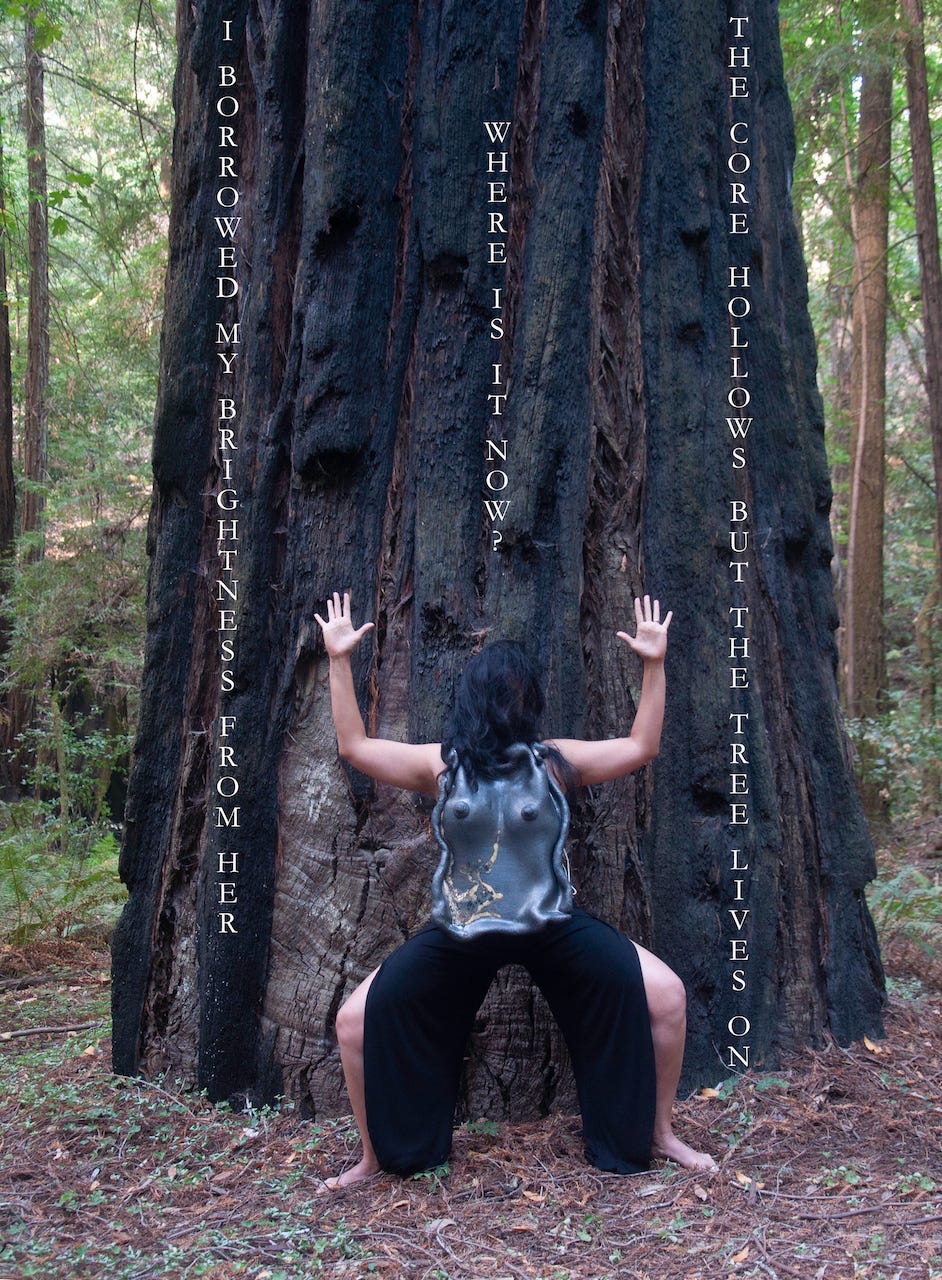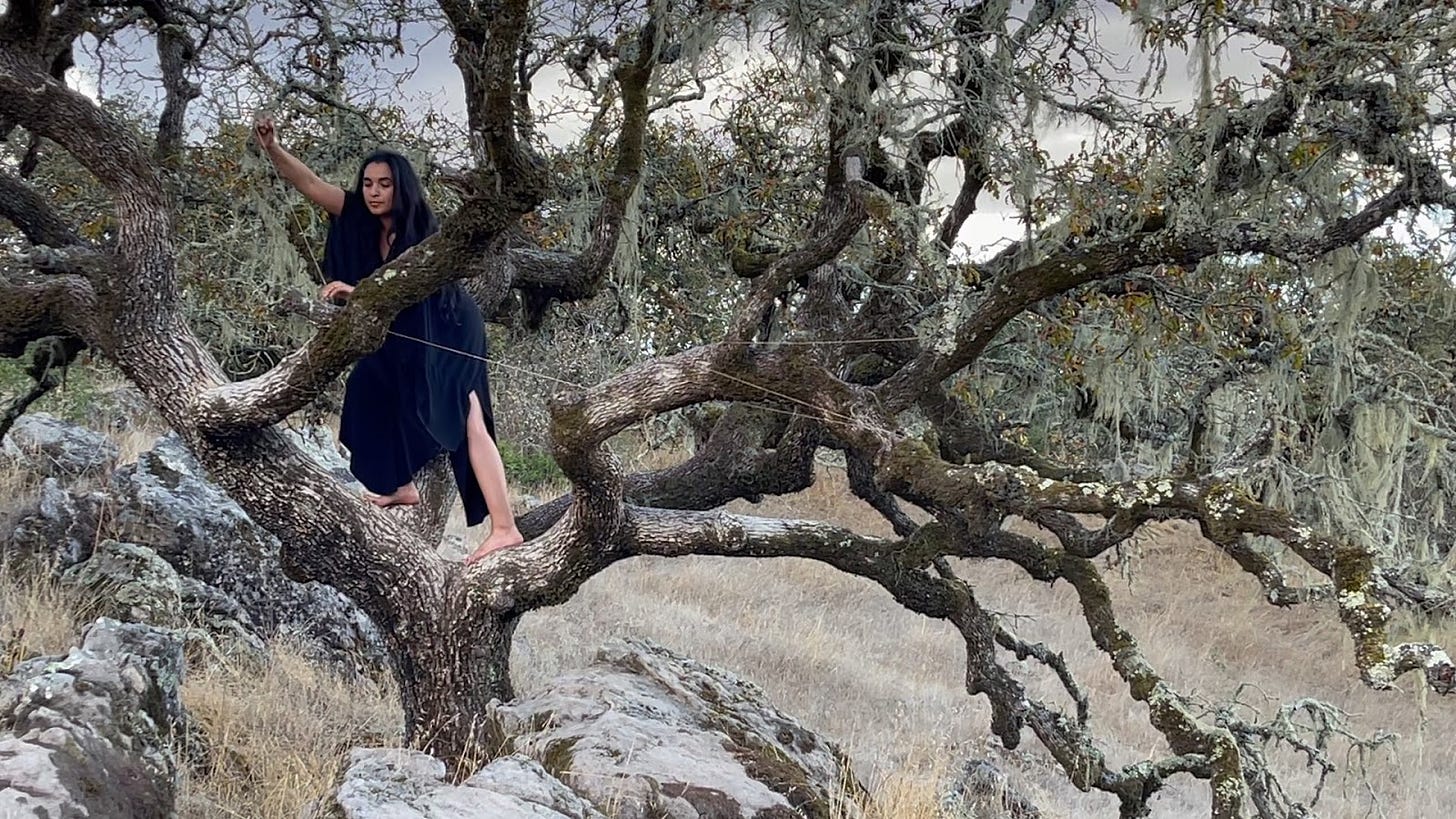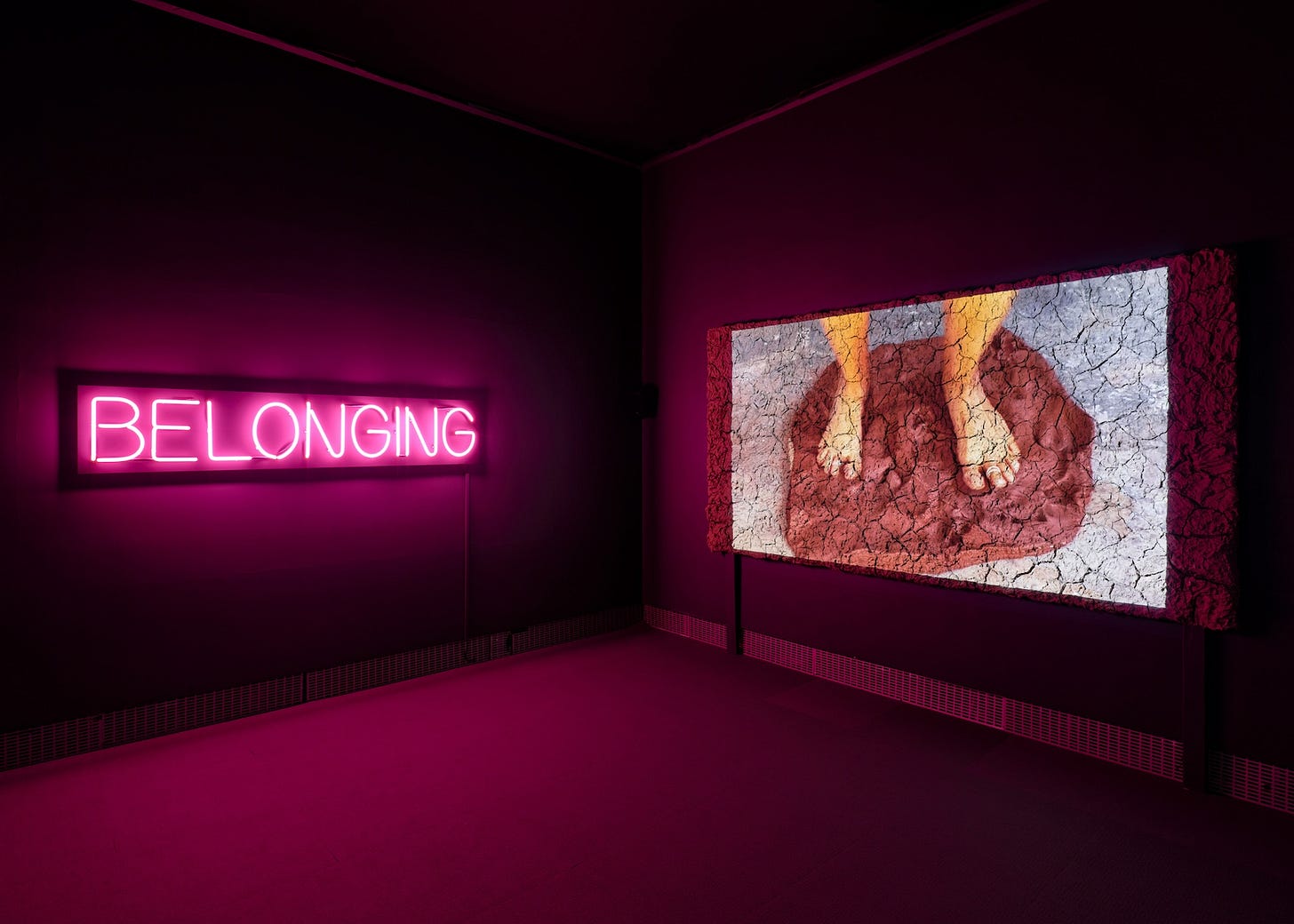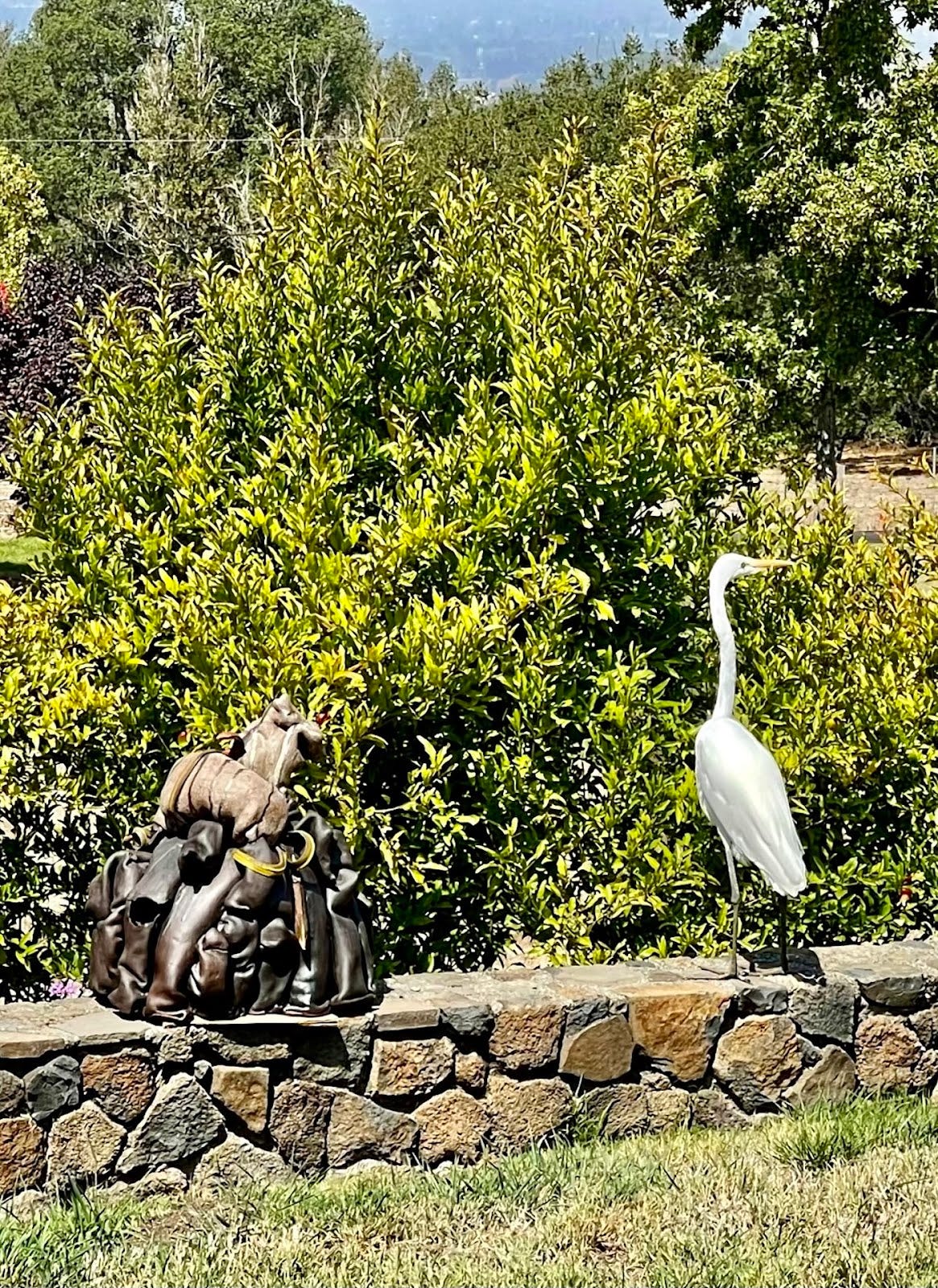Scrapbook's Artists & Aesthetes series presents artist Ashwini Bhat
Ashwini Bhat talks about new forms of myth-making, treading gently, and being in this world.
This week, I’m delighted to publish an in-depth interview with artist Ashwini Bhat. Her work falls into the nexus of ecology & body, myth & tradition and is rooted in place in California, in a way that harks back to its soil, uncovering layers through traditional and contemporary rituals. As you’ll read there is a constant push and pull between nature as the other and the self as part of a complex whole. The whole of Bhat’s work could be read alongside Timothy Morton’s Ecology without Nature, and this interview is a great starting point. I’m grateful for the time and consideration Bhat put into this interview.
For the folks in New York, Ashwini Bhat will be showing at the Salon Art Fair (November 7-11) with Shoshana Wayne Gallery, so visit if you can and see her new works in person.
—Renuka Sawhney
Scrapbook is a reader-supported publication. To receive new posts and support my work, consider becoming a free or paid subscriber. For those who already have, I’m deeply grateful.
What do you create, and what drives you to pursue this creative work?
Coming from a background in classical Indian dance, literature, and translation, I create sculptures, installations, and videos to think through the interconnectedness between body and nature, self and other. I create to find my place in this world, to connect with others, to search for the metaphysical, to better understand myself and my relationship to everything around me.
How do you interpret the relationship between myth-making and identity in your art? Do you see your work as contributing to the formation of new identities or the deconstruction of old ones?
My earliest memories around myth are of my sisters reading mythological stories to me and watching a traditional theater called Yakshagana, growing up in rural southern India. So much of my formative years were spent learning Bharatanatyam, a southern Indian classical dance form that is structured with its own stylized storytelling and myth-making. This training and muscle memory continues into my current studio practice. I find I can simultaneously deconstruct the old self and create new identities through my artistic practice.
Recently I’ve been fascinated by references to Yakshis, the nature spirits in Hindu and Buddhist iconographies. But when I decided to incorporate them in my work, I found the necessity to situate them in the present day— in my California surroundings— where I now find my bearings. Hence my Yakshis morphed into these half-woman half-plant bodies, where the flowering-heads of each Yakshi refers to the plants that grow in our garden in Penngrove, in Northern California. Each is also a kind of self-portrait. I find this kind of freedom in creating new identities through my art hugely liberating.
What role do you believe art should play in fostering dialogue around global crises? Do you see art as a tool for activism, reflection, or something else entirely?
I think art has always played a role in fostering and facilitating dialogues and it will always continue to do so. In my practice, I’m interested in exploring whether spiritual encounters can be ignited by acts of attention. One of my projects, Ritual Encounters (Assembling California), celebrates the secular, sacred, human, and non-human environment of Mount Tamalpais, focusing on the microclimates around Mt. Tamalpais in Marin County. In this collaborative project with my partner, the writer Forrest Gander, the Mondavi Center at UC Davis was reconfigured as a kind of temple with satellite shrines celebrating the mountain.
Why Mount Tam? Not because it is supremely iconic, but because it is ordinary, and the ordinary can be charged with relevance and honored, even sacramentalized. Visitors to this installation were invited to circumambulate— to circle in a ritual walk— ceramic steles and biomorphic sculptures that are ringed by dirt mandalas that are themselves edged with hems (hymns) of words. Circumambulation is a ritual of moving around a sacred object, a ceremonial practice that is a part of Hinduism and Buddhism.
Since 2020, I’ve been circumambulating Mt. Tamalpais along with Forrest. Together we’ve been retracing the steps of the poets Gary Snyder, Allen Ginsberg, and Philip Whalen, who in 1965 famously completed their own clockwise hike around the mountain as a ritual meditation, inspiring unknown numbers to follow to this day. I was interested in seeing how through immersion in video, sculpture, poetry, and the clockwise movement of their own bodies through the exhibition, viewers can experience (or recall) their own link to the non-human world, and to reevaluate the ground they stand upon, both physically and ethically.
In what ways do you believe art can serve as a counter-narrative to the dominant myths perpetuated by political parties? How do you see your work engaging with or resisting these narratives?
I find my studio practice comes to serve as a radical revision of our exploitative and transactional relation to a world of complex interrelationships. Recently a poet friend I admire, Don Mee Choi, wrote a reply to my studio newsletter- “Keep creating (in the midst of our terribly destructive world) and I will too!” I believe in every word of this. In my focus on ecological concerns, in my multicultural vitalization of myths, and in my choice to make art in the first place, my studio practice itself is an act of resistance.
How do you approach the creation of art in a world where the boundaries between the personal and the political are increasingly blurred? What strategies do you use to maintain the integrity of your vision in such a context?
I have this strong memory from my early formative years of encountering emotions of empathy and ethical dilemma through literature, translation, theater, and films. May it be the works of Girish Karnad or Samuel Beckett, Satyajit Ray or Ingmar Bergman—their art taught me about how personal choices and actions incur larger than personal repercussions. Isn’t that true in most of our lives? Then how can we separate the personal from the political? I think art allows space for the personal, political, and the inbetween.
Since 2017 everything I make fits into a body of work called Assembling California. After a long period of nomadic life, when I was deciding to set roots in Petaluma, in Northern California, a nearby town (Santa Rosa) burned to the ground. The way the community came together to support one another had a deep impact on me. In fact, my work became entirely focused on California ecology and it felt like my work had a purpose in this world (and life). I want to study my surroundings to see how things are interconnected. I want to share my learning with the world. Not in a didactic way. Not by just concentrating on the loss and grief in the world, but by focusing on beauty, love, tenderness, and regeneration. If I feel transformed by art and the art making, I strongly believe that it is possible to transmute this experience with the larger world.
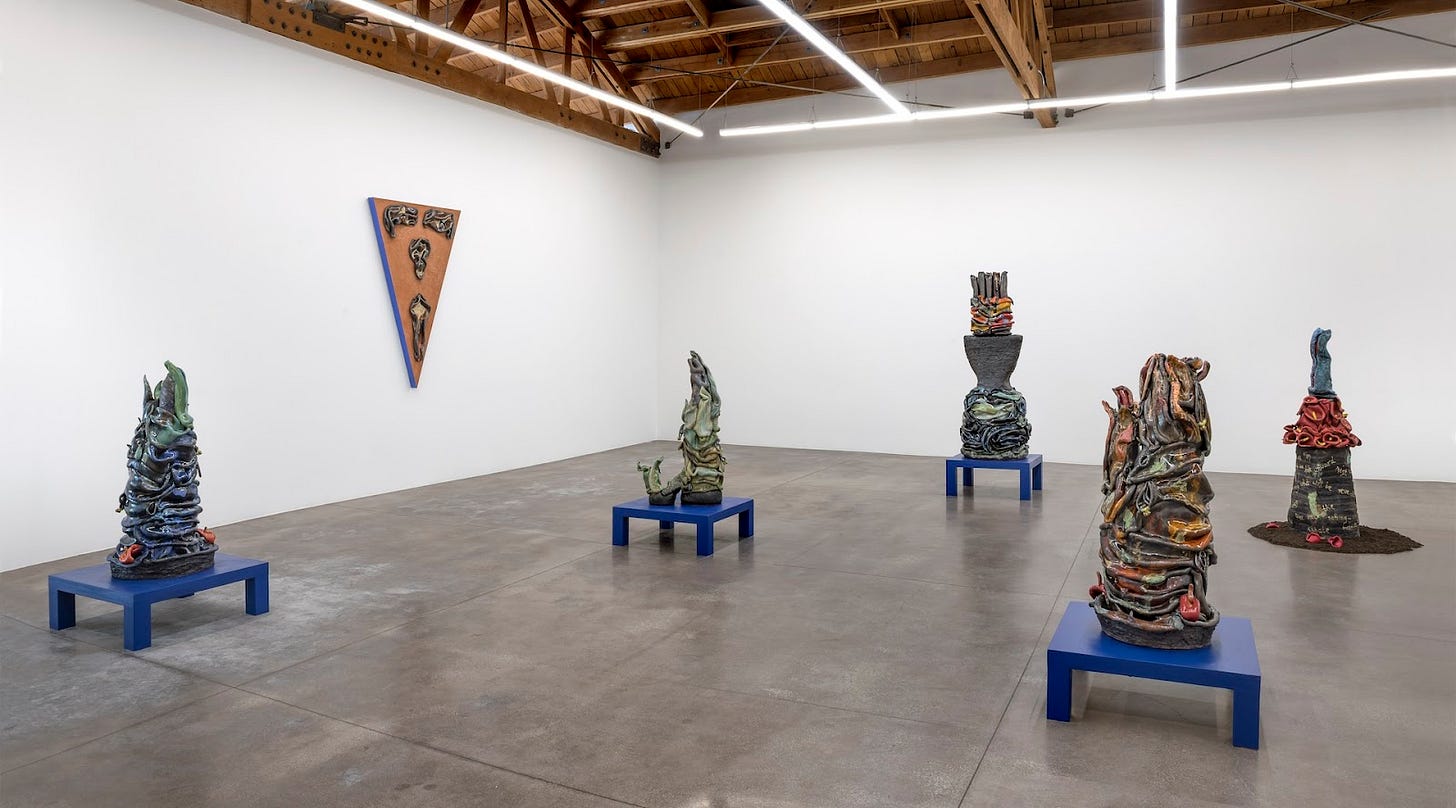
How do you think art can contribute to a more nuanced understanding of the 'other,' especially in a political landscape where differences are often exploited for gain?
Scientists have researched and talked about how interconnected we all are- not just between humans, but in the way, for instance, we share so much DNA with trees, not to mention other mammals. We have had this data for a while now. I believe art can step in a big way, as it has the ability to make people feel. Not just share the data and consume information, but to really feel the urgency and necessity to understand the “other”.
My entire practice is thinking through questions of —what does singular identity even mean if we are composed of innumerable organisms? In what ways has our tendency toward logocentrism limited the breadth of our vision? How can art renew perceptions of form, relationships, the familiar? In my most recent solo exhibition at Project 88 Mumbai, even though most of the works were self-portraits, I titled the exhibition as Her Nature (not My Nature). I wanted to focus on a third person, turning the idea of an individual self into something of a larger presence that invokes plural belongingness and interdependencies.
In your view, what is the role of materiality in myth-making? How do you use materials in your work to challenge or support existing myths?
I almost always start with poetry. Text often brings in the visual and formal inspirations. Someone close to me once said, “when you find your material you will find your happiness”. Finding clay was that for me. I’ve been drawn to bronze for decades and recently started working in bronze and steel. I love rust. I love all materials that go through intense transformation. Starting with the human body. My work always begins with the body and comes back to the body. Whether I’m taking long arduous hikes as part of my research trip, or whether I’m forming hundreds of pounds of clay in my studio, I’m always aware of my body as a main character, in constant collaboration with everything around me. I often use thinly stretched clay slabs over my own body- almost like draping them over me, imagining going under the layer of earth, or wearing the earth’s layer as my skin. My work responds to the phenomenon of the rift, the rupture, and the renewal of nature, body, clay, and self. And through my tumultuous, color-dappled sculptures I find a connection between the fire-and-earthquake-altered landscape of California, and mythologies of Kali as a goddess of creation and destruction.

How do you perceive the tension between the need for art to be accessible and its role in challenging or subverting dominant cultural narratives?
Do they need to be opposing things?
How do you see the role of art in the context of community-based narratives, particularly in terms of creating or reinforcing a sense of collective identity amidst global crises?
I’ve been increasingly interested in community based projects. I recently finished a number of immersive and interactive movement projects, one of them being at Santa Barbara Museum. Hundreds of people came together to first create a clay textured wall onto which a video of mine was projected. I had shown a similar projection at YBCA in San Francisco in 2023 where it was accompanied by a neon work that says BEING, LONGING, BELONGING. And at Santa Barbara I was developing that idea further. While the video was being played in a loop, I started creating a mandala out of clay coils and very soon the public joined, moving very intentionally and feeling our own breath and each other’s presence while rhythmically stepping on the clay. The performance piece is titled, “Earth Under Our Feet” I borrowed it from George Oppen, an Objectivist poet from San Francisco. It pays attention to impermanence and what usually gets ignored by our human centric gaze. These public immersive works are very cathartic. I’ll continue to pursue community based projects to reinforce a sense of collective identity.
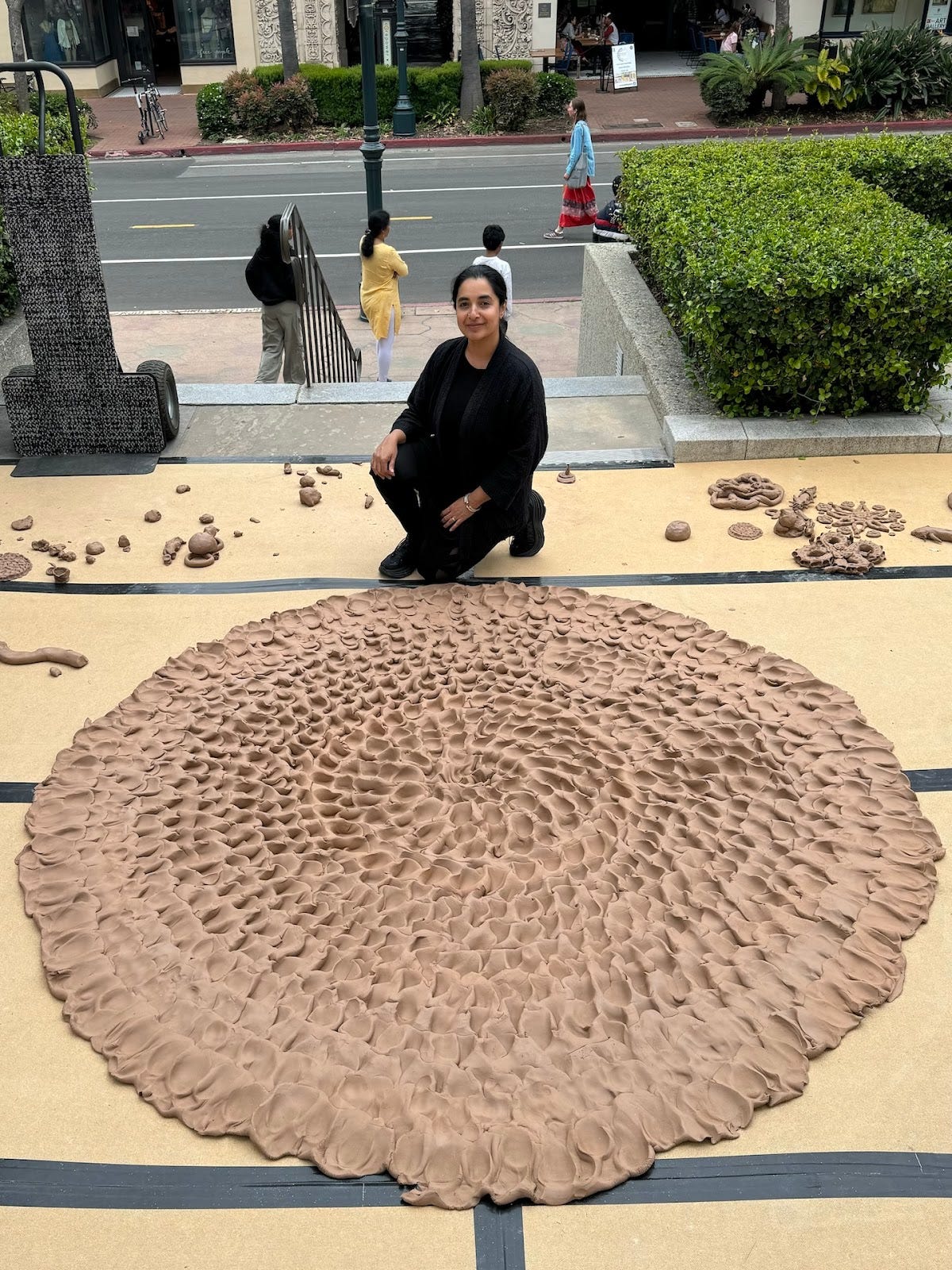
Considering the concept of non-alignment, how do you navigate the challenge of creating art that is both politically resonant and independent of specific ideological frameworks?
I want to ask the questions even when I know the answers are complex, and perhaps not there (yet). One of my most recent public art projects “What Will It Take/ For Us To Awake?” has now been seen in two locations. The first edition of this bronze sculpture is now a permanent installation at the Asian Art Museum in San Francisco, occupying a prominent location at the entrance of South Asia galleries. The second edition of this bronze sculpture is installed in the Regents Park in London, for Frieze Sculpture 2024, curated by Fatos Ustek. Both these installations reference the sensual form of the calla lily as a symbol of growth and resilience while alluding to the emergency alerts of wildfire season here in California. For many years now I've been working with the motif of calla lily as a symbol for regeneration of (female) body and nature.

Bells have traditionally been rung through the centuries to raise the alarm for local communities or to mark significant moments of celebration. In Hindu, Buddhist, and Jain temples, the act of ringing the bell is considered auspicious and believed to induce mindfulness. On the eve of the United Nations Climate Conference in Glasgow 2021 (the COP26 summit), many cathedrals joined in to create sacred noise by ringing their bells at 11 am to call out the 11th hour of awareness for climate action. This body of work metaphorically suggests a similar wake-up call, focusing our attention on the climate emergency, stressing the urgency for us to act more intentionally to tread lightly on this planet.

In the age of polycrisis, where crises overlap and magnify each other, do you think art has the power to address the complexity of these issues? How does your work attempt to untangle or reflect these overlapping crises?
I think we are living in a time where all crises are post-national, they are bigger than the human-made national geographic or political boundaries. When I lived in Chennai in 2006, trying to survive as a dancer while doing two other day jobs to pay bills, I lived in a small warehouse, where I had access to running water once a week on Tuesdays between 6 am- 8 am. I had these large drums of water to collect water for the rest of the week. The shortage of water we are now facing in California, people in the developing world have been facing for the last 20 years at least. But now the climate change and the various disastrous upheavals in nature are no longer just in developing countries.
My partner and collaborator, Forrest Gander and I now are turning our garden into a California native garden with plants that are drought tolerant or native wildflowers, that are perennials. We removed the lawn and covered the ground with the lava rocks that came locally from St Helena. I’m truly interested in seeing how smaller communities can come together and help each other to be more kind to one another, to practice care for the animals, plants, and the surroundings. One of the things that my work focuses on is the connection of our human bodies with nature. I feel transformed by my exploration of California. I don’t see much of a difference between the way I want to live and the way I want to create. For me, these two are extremely connected and linked.
As an artist, how do you confront the fractures and ruptures in society—whether political, social, or environmental—through your work? Do you see these fractures as opportunities for new forms of myth-making?
I’ve been increasingly wanting to be in the company of animals and trees: a deep desire to be quiet with them while so much can be communicated through touch, a slow blink, a purr, or habitual rituals. I go on these long walks with my two cats— Jalebi and Jamoon. They are also my studio companions. I see them as my best friends, collaborators, and co-conspirators. I have learned so much about myself through them, and have learned so much about the garden through their eyes.
I have learned a great deal from this land. How do I “other” myself in this equation? I find there’s something so raw, personal, and spiritual in my studio process, in creating new forms of myth-making but it also accesses feelings that are universal. I’ve also had this extremely strong realization that I want to tread gently, and be in this world in a certain way. I think I was heading in this direction for a really long time now. But especially in the face of all human tragedies, this time of environmental crisis, I’m finding it extremely essential for my survival to be making art. It’s through my practice that I have built a community around me. And it’s through my practice that I create work that celebrates co-existence, that makes contact with and asks questions of others.
After thirty-five years in Southern India, transdisciplinary artist, Ashwini Bhat now lives and works in the foothills of Sonoma Mountain, California, with her husband, writer Forrest Gander. Coming from a background in literature and classical Indian dance, Bhat works in sculpture, ceramics, installation, and video, developing a unique visual language exploring the intersections between body and nature, self and other. Her practice draws from her rural agrarian community upbringing. Her work is influenced by syncretic shrines, rituals, & non-Western metaphysical concepts of empathy for the non-human. Bhat’s work, in part, is an act of (re)mapping consciousness, contributing to a spiritual or psychological archive, with an emphasis on the transformative aspects of place.
Bhat is a is a 2024 John S. Knudsen Prize winner and a 2023 United States Artists Fellow. She has also received the Howard Foundation Award for Sculpture, the McKnight Foundation Residency Fellowship, and the Julia Terr Fellowship. Her work is exhibited nationally & internationally and can be seen in collections at the Newport Art Museum, Brown University’s Watson Institute, New Bedford Historical Society (USA); Shigaraki Ceramic Cultural Park (Japan); FuLe International Ceramic Art Museum (China); Daugavpils Mark Rothko Centre (Latvia); and in many private collections. Her sculpture also has been widely reviewed and featured in Art and Cake, Los Angeles Review of Books, Bay Nature, PinUp Magazine, New City Mag, American Craft Council, Alta Journal, Brooklyn Rail, Lana Turner: a Journal of Poetry and Opinion, Riot Material, Ceramic Art and Perception, Ceramics Ireland, New Ceramics, Caliban, Crafts Arts International, The Studio Potter, Logbook, and Ceramics Monthly.
In 2023, Bhat became a certified Naturalist at the Fairfield Osborne Preserve, a research site for Sonoma State University’s Center for Environmental Inquiry. She is represented by Shoshana Wayne Gallery, Los Angeles, USA, and Project 88, Mumbai, India.





